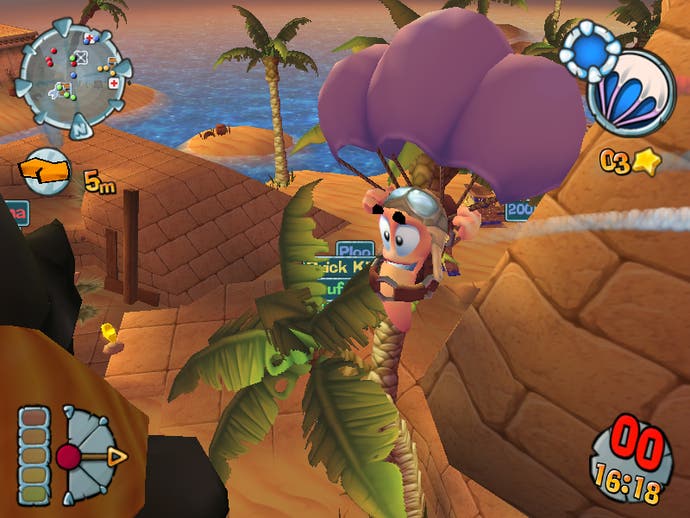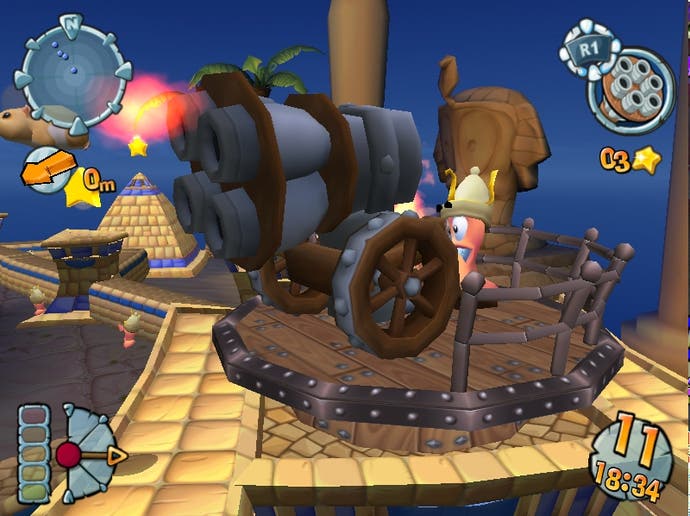Worms Forts: Under Siege
We fort this was going to be good.
Nobody has done more for the reputation of the humble worm than Team 17. Over the past decade, the Yorkshiremen behind the world's most anarchical turn-based strategy game have bolstered the unassuming annelid's credentials to such an extent that gamers arguably get more of a rise out of them than the average invertebrophile - and that's an achievement not to be squashed idly underfoot.
Unfortunately, in the case of Worms Forts: Under Siege, the series' undoubted pedigree merely serves to underline just how far the worm has turned away from the origins of its simple brilliance. Besieged by newfound complexity, Forts is more sloth than worm, taking far too long to get going and lacking the razor sharp wit and pace as well as the left-right-click-fire simplicity of its progenitor once it does.
Siege here

Classic Worms involved two opposing teams chucking explosive sheep, Holy Hand Grenades and other comedy projectiles at one another, and swinging around like Tarzan with the legendary ninja rope across tight, beautifully drawn and crucially destructible environments. Worms 3D just gave it another dimension; many would say to its detriment. Forts picks up from there, and introduces base-building ideas; now you start with a central fort and build outwards every turn, opening up advanced weaponry and other options as you take over the "victory locations" dotted around the map, in addition to trying to pulverise your adversary with bishop-launching cannons and explosive fridge-freezers full of equally explosive frozen ferrets.
But it's lost far more than it's gained. Presumably in order for the base-building to work, Forts has been stripped of the series' trademark destructible landscapes, so that only the worms and buildings can be shot to pieces. Which immediately sacrifices the much-loved possibility of blowing the ground out from under each other, or seeing a wayward rocket carve a makeshift stairway out of a cliff, which conveys a tumbling barrel of napalm onto the unlucky troopers below.
This alone feels like a grave mistake, but it's far from Forts' worst crime. It's rife with other issues; unlocking new weapons which can only be fired from atop certain buildings is a clever idea, but building bases is monotonous, and making good use of the weapons at your disposal is so difficult to do. Things like the springy double-jump may help you cover significant distances, but your journeys these days are generally only round trips from the top of a decent building to a weapons crate and back. The game actually seems to be designed to discourage you from moving around the map.
Naptime

By far the most frustrating thing about Forts though is the pace. Or the total lack thereof. It used to be that we'd sit there hammering the mouse button to try and speed things up because we eagerly wanted to get on with smashing the bejesus out of each other. Here we just hammer it to help pass the time. The addition of base-building means that you can win either by destroying your enemy's stronghold or by killing all his worms, but either approach takes hours - and that's not too much of an exaggeration. The final tutorial mission, which is your first proper battle against a team of AI-controlled worms, took us 45 minutes to successfully complete - and that was on our fifth attempt.
Beyond that, there are all sorts of little hold-ups to grit your teeth through; waiting for your weapon to turn round because it always seems to be pointing the wrong way, waiting for your enemy to move at all (they'll happily do laps round towers, or sit there for ten seconds contemplating whether or not to collect the crate sitting literally a handful of pixels in front of them, rather than getting on with it), waiting for the turns to switch over, waiting for your worm to idle glacially between two points, waiting for animations for virtually everything to end, waiting for scores to tot up, waiting for crates to land, waiting for buildings severed from the stronghold to collapse, waiting for the single-player mission briefings to stop wise-cracking and actually say what they want you to do. There's so much waiting around.
When eventually you do take control you're not free from the waiting by any means, but, worse, you're also hamstrung by things like the awkward camera, the obstinate control system in general, the keyboard-controlled base-building system which wants to cycle every possible location for your proposed extensions before settling on the one you actually wanted, and quirks like worms getting stuck on battlements, and worms jumping in the wrong direction (why on earth have backflip as the default double-jump action?), amongst numerous other niggling flaws.
The never-ending story

There's quite a lot to do. In addition to the usual multiplayer hot-seat options (Worms always was best played with two people sat at the same PC) and Gamespy-powered matchmaking service WormNet (completely empty when we checked), there are single-player Campaign and Trials modes. Campaign has you completing various tasks using your worms and limited munitions and tools, like collecting far-flung crates and then clambering up to a victory location, and takes you on a tour of the game's four different period designs, while the Trials are basic deathmatch scenarios played against the AI. Both will unlock all sorts of trinkets to tinker with.
But you just won't be interested in doing any of it. Comedy sound schemes have totally lost their impact for some reason (presumably because it takes about ten minutes now to hear five or so of the worms' custom outbursts), and even the weapons seem to have lost their appeal. You may chuckle the first few times you see them in action, but the monotony of sitting around playing Worms Forts soon takes the shine off - and there's not much shine to go around in the first place. Bishops may flail their rods in midair and grannies may descend their stair-lifts with lovingly animated precision, but the rest of the in-game visuals - the environments in particular - have slipped from "cartoon-like" into the realms of "dreary and featureless".
There is some fun to be had here, but there's too much waiting around and too much mechanical frustration standing between you and said fun that the pay-off is inevitably toothless. Games are too long and drawn out, and in all our time with this we've never experienced the wonder of conquering the remaining members of the opposing team with one surviving worm's audacity, nor any of the countless other exciting and uplifting outcomes familiar to fans of Worms' once finely balanced gameplay. In fact, half of our games lacked outcome at all, with the two teams having to be picked apart on aggregate health after around an hour of cack-handed almost-bludgeoning and constant rebuilding.
Subterranean
It feels like it's being choked to death by its own ambition. Team 17 obviously knew it had to try something new in order to keep pumping out Worms titles, but while it sounds like it might work on paper, the fort-versus-fort gameplay definitely doesn't gel with the Worms dynamic. Instead it robs a once-proud series of almost everything that made it so memorable, and the result is a game that tires as much as it feels tired. We hope the Yorkshiremen continue to develop Worms in new directions, and commend them for giving it a go with Forts, but if the series is to regain its former glory then mere refinement probably won't be enough.

